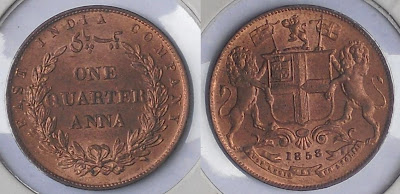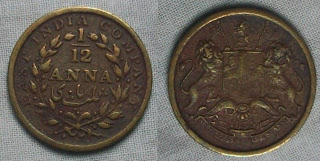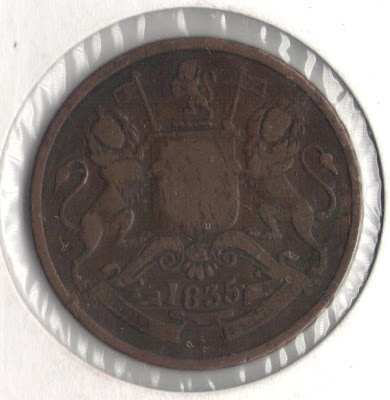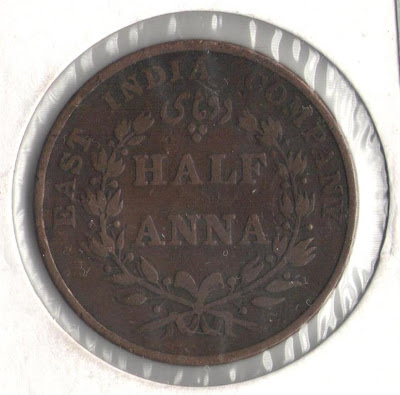East India Company half pice

East India Company quarter anna, 1858

East India company 1/12 anna

East India company quarter anna, 1835

 This half anna coin was minted in 1835 and is definitely not easy to find. It is a large coin about the size of a half crown or the Nehru 5 rupee. On the reverse we can see the coat of arms of the East India company.
This half anna coin was minted in 1835 and is definitely not easy to find. It is a large coin about the size of a half crown or the Nehru 5 rupee. On the reverse we can see the coat of arms of the East India company.The East India company was founded for trading purposes. After a rival company challenged the monopoly of the company , the two companies were merged to form a single entity which came to be known as the honourable east india company or company John or company Bahadur. The company traded mainly in silk, cotton, indigo dye, spices and opium. In time it came to rule a significant portion of India through its various policies. The company enjoyed various monopolies and exemptions from the British monarch and this caused lots of resentment in its competitors. In spite of this resentment, the company enjoyed enormous power and profit for almost 200 years.
The East India company first came to India during the reign of Jahangir somehwere around 1616. They came as traders initially, but in time their interest went towards control and domination of the country which was full of wealth. They started to interfere in the affairs of the different states and also started to exercise military control and assumed administrative functions as well. The princely states grew increasingly uncomfortable with the policies of the East India company.
A decisive stage as regards the company rule in India came with the Battle of Plassey in 1757. The Nawab of Bengal Siraj-ud-Daula had to wage a battle with the company led by Lord Clive, whose numbers were vastly inadequate as compared to the numbers of the Nawab's army. But clive had made a secret pact with Mir Jafar, who controlled quite a significant portion of the Bengal army. Mir Jafar had been promised the throne of Bengal by Clive. So when Jafar's troops did not take part in the battle, the morale of the Nawab's army went down; but still their numbers were about 4 times those of Clive's army which consisted of 950 Europeans and about 2100 Indian sepoys. There were moments when the English could have left the battle but a cannonball strike killed the army chief Mir Madan and the resulting confusion and chaos turned the tide in Clive's favour. The English gained control of Bengal following this battle and this also rang many a bell in the Indian princely states.
The British continued to deploy this policy of divide and rule quite effectively for the next 100 years to gain domination of the different states. They enetered into agreements with different states if they were considered strong enough so as not to be easily conquered, but later annexed them as and when there came a time of internal strife or rule by some ineffective and weak prince. Another notable policy was the doctrine of lapse, which refused to recognize an adopted heir, and in the case the company took over the reins by default. A case in point would be that of Rani Laxmibai of Jhansi, who was the adopted heir of Nana Saheb Peshwa and fought with all she had till the bitter end.
The British had certain practices which invoked the ire of the ruling princes and the masses alike. The rulers were annoyed in the least to have their powers usurped like it was nothing , and the peasants had to pay heavy taxes. The use of the Enfield rifle was very controversial as the cartridge which had to be bitten of was thought to be comprised of pork and beef, so it was sacrilege to both Hindus and Muslims alike. This was the cause of the sepoy mutiny of West Bengal heralded by Mangal Pandey was the trigger for the first war of independence, 1857.
After this revolt, the reins of the East India company went to the British monarch, Victoria at that time and effectively ended company rule. The company was finally dissolved on 1st Jan, 1874.


6 comments:
Thanks for a very interesting and informative post. I don't know much about coins, but recently came into possession of a somewhat tarnished copper coin which claims to have been minted by the EAST INDIA COMPANY UKL in 1818. The denomination is one anna. On the obverse side is a tableau with (I think) Ram, Seeta, Lakshman and Hanuman (the latter sitting at Ram's feet). The coin is reasonably good condition as in all lettering etc. is clearly visible, but patches have become greenish and somewhat darkish.
How do I know if this is a genuine coin, and not a forgery or an issue by someone else, even if not from a different period?
I would be grateful for your help.
Hello, sorry I am writing again. If you can help me, can you please email me at banpriyo@lycos.com? Thanks,
P. Banerjee. This is about the 1818 copper coin.
hey....this coin seems to be fake.....
check out FAKE COINS under categories to get more info...
Wow, your page is very impressive. i have a handful of old coins from the world over and was interested in their history, the 1st one i had decided to research was the HALF ANNA from the EAST INDIA COMPANY 1835, almost identical to the one in the image on your page, except mine is of better condition. I just wanted to really say how useful and informative your site has been. Thankyou. e.craig
U are always welcome!!
WOW! These coins are awesome and want to say thank you for the sharing.
Post a Comment